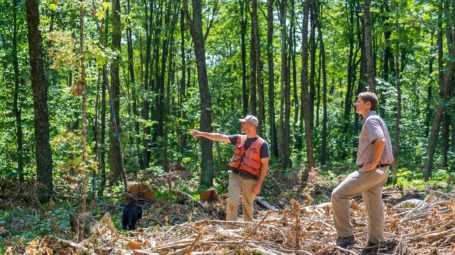One of two trails is closed through September and October
Birding at our Pratt Refuge property in Duxbury is about to get even better!
Throughout the months of September and October, VLT is creating over 15 acres of high-quality habitat for migratory birds who rely heavily on the property as a breeding ground. During this time, the property will remain open for recreational use (and birdwatching, of course!). However, one of the property’s two trails will be closed through the end of October.
Building breeding habitat for birds
As climate change compounds threats from habitat loss, degradation, and fragmentation, migratory bird numbers are in decline. Woodland owners and managers can help by mimicking the natural processes that occur in our forests to create higher quality bird habitat.
This fall at VLT’s Pratt Refuge, we are creating migratory bird habitat on 15 to 18 acres of the property’s 500+ acres. We will employ forest management practices recommended by the Audubon Silviculture with Birds in Mind program to invite more diverse tree species of varying sizes, providing more resources and safe places for the birds to breed.
The improvements, funded through a grant from the Cornell University’s Land Trust Bird Conservation Initiative and implemented in partnership with Audubon Vermont and the Vermont Youth Conservation Corps (VYCC), will benefit a broad range of birds including the Black-throated Blue Warbler, Canada Warbler, Wood Thrush, Bicknell’s Thrush, American Redstart, and Blue-headed Vireo.
“We’re excited to implement these changes and monitor their impact on bird populations at Pratt Refuge over time,” said VLT forester Caitlin Cusack, who is overseeing the project. “And by increasing the diversity of tree ages, species, and vertical and horizontal structure this work also increases the ability of the forest to respond to a changing climate.”
What to expect when visiting the property
The migratory bird habitat improvements happening at Pratt Refuge will be implemented by property manager and local logger Max Popowicz throughout September and October. During this time, the refuge’s Field trail will remain open. However, the trail on the south side near the cabin will be closed.
While the work is being conducted, visitors are welcome to park in the parking area. If the parking area is full, please park along the right side of the road as you proceed uphill. From there, you can walk through the field to the trail.
How and why are we doing this?
The overall design of the habitat improvement project will transform the site from a structurally simple forest to one with well-developed understory, midstory, and canopy layers. These layers offer nesting, perching, and foraging sites, and protective cover for a greater array of bird species.
VLT will create the migratory bird breeding habitat in two phases. During the first phase in September, we will cut trees that are crowding priority tree species, freeing up room and sunlight for those trees to grow. Priority tree species include black cherry, sugar maple, yellow birch, spruce, red maple, and female white ash. The activity is an Audubon Silviculture with Birds in Mind management practice called a crop tree release.
During the second phase of the project in December, a VYCC sawyer crew will create a two-acre opening of young forest by removing most trees greater than two inches in diameter. This will create an early successional habitat that provides additional breeding habitat for species including chestnut-sided warblers, mourning warblers, and white throated sparrows.
Questions?
If you have questions, you can get in touch with Caitlin Cusack.
Contact Caitlin













